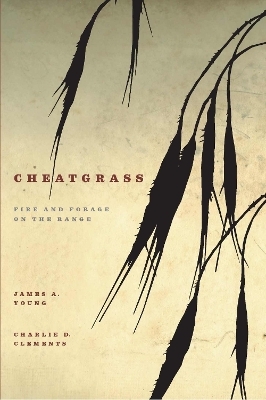
Cheatgrass
Fire and Forage on the Range
Seiten
2022
University of Nevada Press (Verlag)
978-1-64779-070-7 (ISBN)
University of Nevada Press (Verlag)
978-1-64779-070-7 (ISBN)
Cheatgrass is an exotic species that appeared in North America in the late nineteenth century and has since become a dominant plant in the arid rangelands between the Sierra Nevada, Cascades, and Rocky Mountains. This book provides a comprehensive study of this invasive plant that has changed the ecology of millions of acres of western rangeland.
Cheatgrass (Bromus tectorum, downy brome) is an exotic species that appeared in North American in the late nineteenth century and has since become a dominant plant in the arid rangelands between the Sierra Nevada, Cascades, and Rocky Mountains. A shallow-rooted annual, it is the first grass to appear after the region's long, cold winters and has become an important forage plant for livestock and wildlife. It is also a major environmental hazard in the sagebrush plant communities where it has established itself, providing fuel for the ferocious wildfires that have ravaged so much of the Great Basin since the mid-twentieth century.
Cheatgrass is the first comprehensive study of this highly invasive plant that has changed the ecology of millions of acres of western rangeland. Authors James A. Young and Charlie D. Clements have researched the biology and impact of cheatgrass for four decades. Their work addresses the subject from several perspectives: the history of the invasion; the origins and biology of cheatgrass, including the traits that allow it to adapt so successfully to a wide range of soil and precipitation conditions; its genetic variations, breeding system, and patterns of distribution; its impact on grazing management; and the role it plays, both positive and negative, in the lives of high desert wildlife. The authors also describe efforts to control cheatgrass and offer some new approaches that have the potential to halt its further expansion.
Cheatgrass (Bromus tectorum, downy brome) is an exotic species that appeared in North American in the late nineteenth century and has since become a dominant plant in the arid rangelands between the Sierra Nevada, Cascades, and Rocky Mountains. A shallow-rooted annual, it is the first grass to appear after the region's long, cold winters and has become an important forage plant for livestock and wildlife. It is also a major environmental hazard in the sagebrush plant communities where it has established itself, providing fuel for the ferocious wildfires that have ravaged so much of the Great Basin since the mid-twentieth century.
Cheatgrass is the first comprehensive study of this highly invasive plant that has changed the ecology of millions of acres of western rangeland. Authors James A. Young and Charlie D. Clements have researched the biology and impact of cheatgrass for four decades. Their work addresses the subject from several perspectives: the history of the invasion; the origins and biology of cheatgrass, including the traits that allow it to adapt so successfully to a wide range of soil and precipitation conditions; its genetic variations, breeding system, and patterns of distribution; its impact on grazing management; and the role it plays, both positive and negative, in the lives of high desert wildlife. The authors also describe efforts to control cheatgrass and offer some new approaches that have the potential to halt its further expansion.
The Many Faces of Cheatgrass
Developing a Perspective of the Environment
Preadaptation of Cheatgrass for the Great Basin
Scientific Perceptions of Cheatgrass
Seral Continuum: The First Step
Seral Continuum: Intermediate Step
Seral Truncation
The Competitive Nature of Cheatgrass
Genetic Variation and Breeding System
Control of Cheatgrass and Seeding Prior to Herbicides
Control and Seeding with Herbicides
Revegetation Plant Material
Cheatgrass and Nitrogen
Grazing Management
Cheatgrass and Wildlife
Wildfire on the Range
Conclusions
Appendix: Common and Scientific Names of Plants Mentioned in the Text
Notes
| Erscheinungsdatum | 26.09.2022 |
|---|---|
| Zusatzinfo | 43 b&w photos |
| Verlagsort | Reno |
| Sprache | englisch |
| Maße | 151 x 226 mm |
| Gewicht | 363 g |
| Themenwelt | Sachbuch/Ratgeber ► Geschichte / Politik ► Allgemeines / Lexika |
| Sachbuch/Ratgeber ► Natur / Technik ► Natur / Ökologie | |
| Naturwissenschaften ► Biologie ► Botanik | |
| Naturwissenschaften ► Biologie ► Ökologie / Naturschutz | |
| ISBN-10 | 1-64779-070-0 / 1647790700 |
| ISBN-13 | 978-1-64779-070-7 / 9781647790707 |
| Zustand | Neuware |
| Informationen gemäß Produktsicherheitsverordnung (GPSR) | |
| Haben Sie eine Frage zum Produkt? |
Mehr entdecken
aus dem Bereich
aus dem Bereich
eine Geschichte von unten
Buch | Hardcover (2024)
Tropen (Verlag)
CHF 36,40


